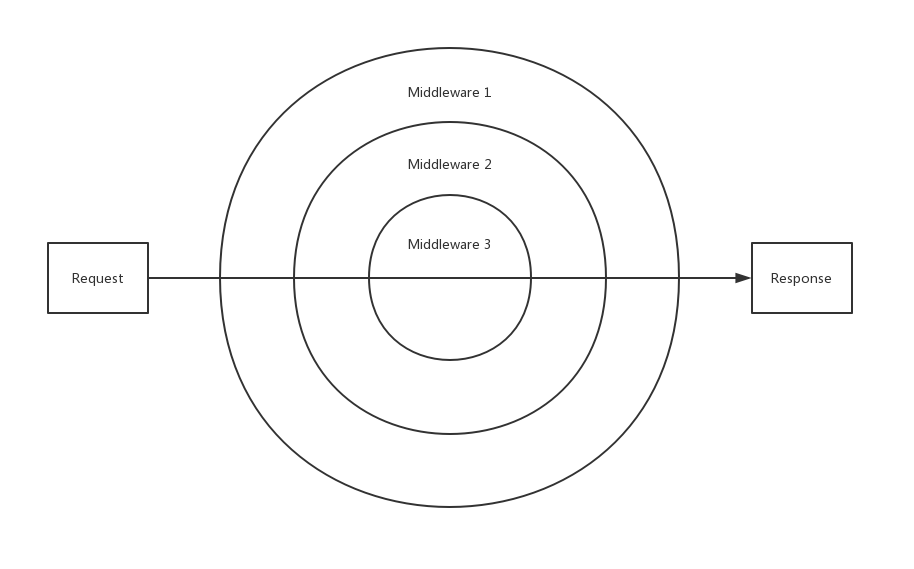AOP 使用入门及适用场景
AOP 与Middleware 非常相似, 当你熟练掌握Middleware 时, 相当于也掌握了AOP
我们先回顾下Middleware 调用流程:

可以通过配置或者注解使用Middleware
1
2
3
4
5
6
7
8
9
|
Router::get('/', 'App\Controller\IndexController::index', ['middleware' => [CorsMiddleware::class]]);
#[Middleware(CorsMiddleware::class)]
class IndexController
{
...
}
|
Middleware 作为解耦神器, 非常普遍的应用在各个服务中
但是, 这么好用的功能仅能作用在Controller 上, 岂不是很可惜?
AOP 可以简单理解为, 可以作用在任何Class 的Middleware:
1
2
3
4
5
6
7
8
9
10
11
12
13
14
15
16
17
18
19
20
21
22
23
24
25
26
27
28
29
30
31
32
33
34
35
36
37
38
39
40
41
42
43
44
45
46
47
48
49
50
51
52
|
use Hyperf\Di\Aop\ProceedingJoinPoint;
class A
{
public function test()
{
echo 'this A'.PHP_EOL;
}
}
class B
{
public function test()
{
(new A())->test();
echo 'this B'.PHP_EOL;
}
}
(new B())->test();
class AOP
{
public array $classes = [
A::class,
B::class,
];
public function process(ProceedingJoinPoint $proceedingJoinPoint)
{
$className = $proceedingJoinPoint->className;
$methodName = $proceedingJoinPoint->methodName;
echo "{$className}::{$methodName} Before".PHP_EOL;
$result = $proceedingJoinPoint->process();
echo "{$className}::{$methodName} After".PHP_EOL;
return $result;
}
}
|
AOP 使用场景有哪些? 可以思考Middleware 使用场景有哪些:
- Token 鉴权
- 签名/验签, 加密/解密
- 日志/Tracer
- CORS
- ….
以上场景抽象一下, 得到结论: Middleware 适用于系统功能
同理, AOP 也适用于以上场景, 以及各种系统功能
- Cacheable
- AsyncQueueMessage
- Retry
- Breaker
- Transaction
- RateLimit
- …
以常用的事务举例
1
2
3
4
5
6
7
8
9
10
11
12
13
14
15
16
17
18
19
20
21
22
23
24
25
26
27
28
29
30
31
32
|
use Hyperf\DbConnection\Db;
class A
{
public function foo()
{
Db::beginTransaction();
try{
$model = Model::query()->where('id', 1)->first();
$model->name = 'Hyperf';
$model->save();
Db::commit();
} catch(\Throwable $e){
Db::rollBack();
}
return $model;
}
public function bar()
{
return Db::transaction(function () {
$model = Model::query()->where('id', 1)->first();
$model->name = 'Hyperf';
$model->save();
return $model;
});
}
}
|
AOP 搭配注解写法
1
2
3
4
5
6
7
8
9
10
11
12
13
14
15
16
17
18
19
20
21
22
23
24
25
26
27
28
29
30
31
|
use Hyperf\DbConnection\Annotation\Transactional;
class A
{
#[Transactional]
public function test()
{
$model = Model::query()->where('id', 1)->first();
$model->name = 'Hyperf';
$model->save();
return $model;
}
}
class TransactionAspect
{
public array $annotations = [
Transactional::class,
];
public function process(ProceedingJoinPoint $proceedingJoinPoint)
{
return Db::transaction(function () use ($proceedingJoinPoint) {
return $proceedingJoinPoint->process();
}
);
}
}
|
单一场景下, 闭包写法与注解AOP 差别不大
但如果此时需要加需求, 易读性会截然不同:
1
2
3
4
5
6
7
8
9
10
11
12
13
14
15
|
class A
{
public function bar()
{
return Cache::remember(function () {
Db::transaction(function () {
$model = Model::query()->where('id', 1)->first();
$model->name = 'Hyperf';
$model->save();
return $model;
});
});
}
}
|
1
2
3
4
5
6
7
8
9
10
11
12
| class A
{
#[Cacheable]
#[Transactional]
public function test()
{
$model = Model::query()->where('id', 1)->first();
$model->name = 'Hyperf';
$model->save();
return $model;
}
}
|
AOP 避免回调地狱, 举例, 非正常业务场景
1
2
3
4
5
6
7
8
9
10
11
12
13
14
15
| class A
{
#[Transactional]
#[Cacheable]
#[AtomicLock]
#[Retry]
#[RateLimit(create: 1, capacity: 3)]
public function test()
{
$model = Model::query()->where('id', 1)->first();
$model->name = 'Hyperf';
$model->save();
return $model;
}
}
|
